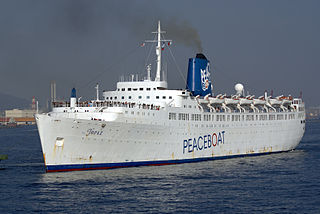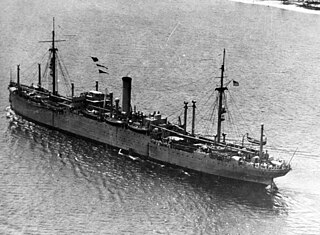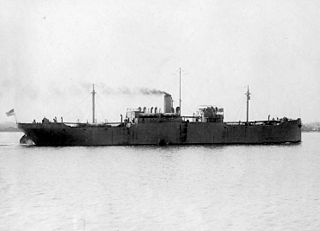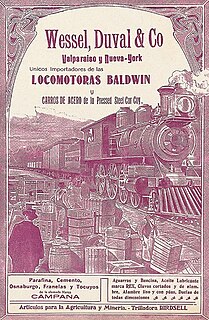Several ships have been named New York City, including:
Five ships operated by Bristol City Line:

APL, formerly called American President Lines Ltd., is a Singapore-based container shipping company that is a subsidiary of French shipping company CMA CGM. It operates an all-container ship fleet, including 153 container vessels.
SS America may refer to:
American Export-Isbrandtsen Lines, New York, was the leading US-flag shipping company between the U.S. east coast and the Mediterranean from 1919 to 1977, offering both cargo ship and passenger ship services, until it declared bankruptcy and was acquired by Farrell Lines of New York.

RMS Empress of Britain was a transatlantic ocean liner built by Fairfield Shipbuilding at Govan on the Clyde in Scotland in 1955-1956 for Canadian Pacific Steamships (CP). This ship — the third of three CP vessels to be named Empress of Britain — regularly traversed the trans-Atlantic route between Canada and Europe until 1964, completing 123 voyages under the Canadian Pacific flag.

USS Rappahannock (AF-6) was a Rappahannock-class stores ship acquired by the U.S. Navy for use in World War I. She served in the dangerous North Atlantic Ocean, delivering animals, such as horses and steers on-the-hoof, to American Expeditionary Force troops in Europe.

The Type C4-class ship were the largest cargo ships built by the United States Maritime Commission (MARCOM) during World War II. The design was originally developed for the American-Hawaiian Lines in 1941, but in late 1941 the plans were taken over by the MARCOM.

SS Mary Luckenbach, was a cargo ship of the United States Navy. She was launched in 1918 and completed the following year by the American International Shipbuilding Corp., Hog Island, Pennsylvania as USS Sac City (ID-3861).
Charlebury was the name of three ships operated by Alexander Shipping Co Ltd.
USS West Mead (ID-3548), also spelled Westmead, was a United States Navy cargo ship in commission from 1918 to 1919.
SS or RMS Parthia may refer to one of two ships of the Cunard Line, named after the historic region of Parthia:
A number of ships have been named Hindostan or Hindustan, after the old name for the Indian subcontinent:

SS New Bern Victory was a cargo Victory ship built during World War II under the Emergency Shipbuilding program. The New Bern Victory (MCV-639) was a type VC2-S-AP2 Victory ship built by Bethlehem-Fairfield Shipyards. The Maritime Administration cargo ship was the 639 ship built. Her keel was laid on January 15, 1945. She was launched on March 8, 1945 and completed on March 31, 1945. The 10,600-ton ship was constructed for the Maritime Commission. The American Export Line and later the Isthmian Steamship Company operated her under the United States Merchant Marine act for the War Shipping Administration. Named for the city of New Bern, North Carolina.

SS Attleboro Victory was a Victory ship built for the War Shipping Administration late in World War II under the Emergency Shipbuilding program. It saw service in the European Theater of Operations in the Atlantic Ocean during 1945, and in the immediate post-war period. Attleboro Victory was part of the series of Victory ships named after famous cities. This particular ship was named after the city of Attleboro, Massachusetts. It was a type VC2-S-AP2/WSAT cargo ship with the United States Maritime Commission (MCV) -"Victory"; hull number 642, shipyard number 1597 and built by Bethlehem Shipbuilding Corporation in Baltimore, Maryland. Phyllis O'Neil of Attleboro, Massachusetts christened Attleboro Victory with a champagne bottle.
SS Charles H. Marshall was a Liberty ship built in the United States during World War II. She was named after Charles H. Marshall, an American businessman, art collector and philanthropist who was prominent in society during the Gilded Age.

SS Augustana Victory was built and operated as Victory ship class cargo ship which operated as a cargo carrier in World War II, and Vietnam War.

SS Fordham Victory was built and operated as Victory cargo ship which operated as a cargo carrier in World War II.
Mississippi Shipping Company of New Orleans, Louisiana was a passenger and cargo steamship company founded in 1919. In 1961 officially changed its name to the Delta Line. The Mississippi Shipping Co. serviced port from the Gulf of Mexico and east coast of South America. The Mississippi Shipping Co. was formed to support coffee merchants and Brazilian produce to New Orleans and up the Mississippi River. competing with the New York City trade. Delta Line failed to upgrade to container ships and modernize as other shipping lines did in the 1970s. In 1982 Delta Line, now owned the Holiday Inn Corporation sold the line to Crowley Maritime. Crowley was the largest US barge and tugboat operator at the time. Crowley started to modernize the ships on the route, but sold the shipping line to the United States Lines in 1985. United States Lines but some of the ship into its routes but went bankrupt in 1986. At its peak in 1949, the Mississippi-Delta line owned 14 ships at a total of 98,000 grt. Delta Line also moved into passenger cruise with to ship. During World War II the Mississippi Shipping Company was active with charter shipping with the Maritime Commission and War Shipping Administration. During wartime, the Mississippi Shipping Company operated Victory ships, Liberty shipss, and a few Empire ships.

Wessel, Duval & Co. was founded in Boston, Massachusetts in 1825 Augustus Hemenway (1805-1876) as Hemenway & Co.. Augustus Hemenway started the shipping company to move his timber products to markets. Augustus Hemenway had timberland in Maine and started his schooner shipping company to take timber to Eastcoast ports. Later he opened a sugar plant in Cuba, his ships would take lumber to Cuba and bring back sugar. Next, he expanded his timber products to Argentina and other Western South American ports. By 1828 the company expanded to Valparaiso, Chile. Augustus Hemenway married into a Boston merchant family, marrying Mary Tileston (1820-1894) in 1840. In 1865 Héctor Beéche (?-1914) became a partner in the firm and a subsidiary company, Wessel, Duval y Cía, was founded in Chile by Charles P. Hemenway, Augustus's brother. Charles had acted on Augustus' behalf in other matters as needed and became a partner in 1870. T. Quincy Browne became a partner in 1870 also and for a few years the firm was called Hemenway & Browne. In 1875 William Muller joined as a partner, the name returned to Hemenway & Co. Augustus Hemenway died in Cuba in 1876. The partnership continued as Hemenway & Co. till 1885. In 1885 Muller retired and Carlos Wolff joined the partnership, the company name was changed to Hemenway, Beeche and Co.. In 1888 Peter "Perdo" M. Wessel (1851-1821) joined the partnership and the company name was changed to Browne, Beeche and Co.. In 1891 a New York City office was opened on 68 Brad Street, and most key workers moved to New York. The next year the Boston office was closed. In 1896 Wolff retired and in 1897 George L. Duval (1855-1931), W. L. Parker, and q became partners. With the new partners, the company name was changed to Beeche and Co.. In 1905 T. F. Budge and Robert Jaffray became partners. In 1907 the company name was changed to Wessel, Duval & Co. In the 1900s the company moved from sailing ships to steamships and opened a new West Coast Line at 47 Cedar Street, later moved to 1 Broadway. The West Coast Line started regular service from New York City to Valparaiso and Callao, Peru. West Coast Line main cargo was railroad and mining equipment to the expanding business in Chile and Peru, along with general cargo. The Chile rail firm, Ferrocarril del Llano de Maipo in Santiago used Wessel, Duval & Co. to import their railroad equipment in 1890. The return cargo from Chile was nitrate of soda. The West Coast Line chartered steamship as needed and was the US manager and agent for other shipping lines. West Coast Line also shipped UK and US coal for coal ships and to nations. For the West coast of South America both the steamer and sail ships used the starits of Magellan, this changed on August 15, 1914, with the opening of the Panama Canal, some routes began to use the Panama Canal cutting about 10,000 miles off the trip. The outbreak of World War I changed service, some charted ships were requisition by their home country, and the United States Shipping Board, gave some ships to the Line to operate for the War effort. Normal operations did not return till 1924, all post-war work have been completed. In from 1920 to 1932, West Coast Line was the US agent for Compania Sud Americana de Vapores, the South America Steamship Company of Chile. South America Steamship Company had luxury passenger service to and from Chile and New York City, on a fleet of luxury steamers: SS Renaico, SS Aconcagua and SS Teno. During World War II Wessel Duval & Company operated ships to support the war in the Pacific War and European theatre. Wessel, Duval & Co. operated some ships in the support of Korean war in the early 1950s. As ships aged and were retired Wessel, Duval & Co. has moved into media, advertising and marketing.